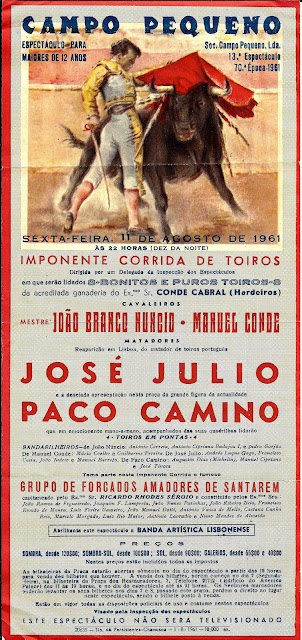An
item like this poster reminds me of how many marvellous times I have had,
some of them eons ago. The memories may not be perfectly detailed but
the feelings rush back with intensity.
I
dragged my reluctant friend to Campo Pequeno in Lisbon for a
bullfight night. She was likely recalling our recent visit to the
bullring in Madrid with its then-mediaeval facilities, most vividly
remembered for the muddy, stinking hole in the ground that passed for
a senoras toilet ... from the stylized drama of the event to the
essentially primitive.
 |
| Plaza Toros les Ventas, Madrid |
I'm
certain there must be upgrades in Las Ventas since then! The world's
most famous venue of the bullfight is massive and of neo-Moorish
design.
But
back to Lisbon. Paco Camino's name stands out on the poster I saved.
He was then twenty-one years old, having been endowed with full
matador status only a few months earlier. It was a privilege to see
him as a rising star, before he eventually became one of Spain's most
honoured toreros.
Bulls
are not killed in Portugal and their corridas de touros are
different from Spain's. The formal sequence begins with the "dance"
of the cavaleiro on horseback; he (or she, as the case may be)
will plant three or four bandarilhas in the bull's back.
Assisted by bandarilheiros on foot with capes to goad and
position the unpredictable bull, the horseman's skill and grace are
the highlight of the performance. A knowledgeable crowd of fans roars
its approval or disapproval. Portuguese Lusitano horses are specially
trained for the arena. Yes, women are nowadays fairly represented in
the ranks of cavaleiras.
 |
| Campo Pequeno, Lisbon |
The
second stage resembles the running of the bulls at Pamplona to the
amateur eye. Eight forcados will enter the arena on foot with
no protection; they form a line to tackle the by-now angry bull. The
goal is to subdue the bull and the front man's job is to secure the
charging animal's head so all his pals can pile on. Their combined
weight eventually tires the animal who is led out of the ring. Let's
just say it's a very dangerous activity, yet there's no lack of
daredevils wanting to participate. Some have dubbed them the Suicide
Squad.
Paco
Camino would not have been performing on a horse. But José
Julío was Portuguese, so
I can assume we saw both Spanish and Portuguese styles that evening.
Of course I had to make online visits to refresh my memory.
Abhorrent
to many people, the bullfight is nevertheless tradition, pure theatre
with Roman gladiatorial origins, a deep part of another culture.
Bullfighters are never, ever called toreadors
as Bizet's opera Carmen popularized ... please:
it's matador.
Sources:
Wikipedia; http://www.gomadrid.com/activity/plaza-toros-las-ventas.html;
©
2018 Brenda Dougall Merriman





No comments:
Post a Comment